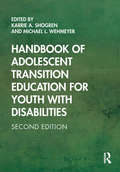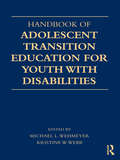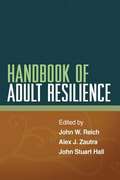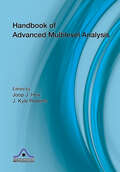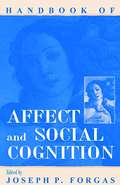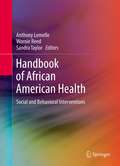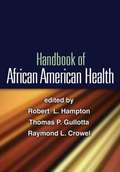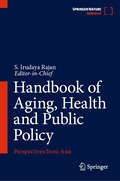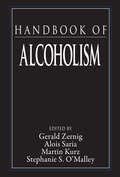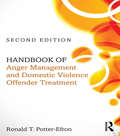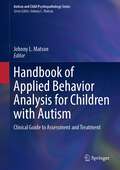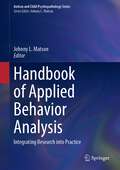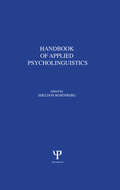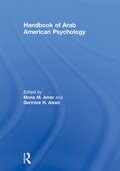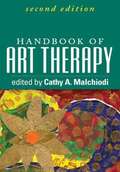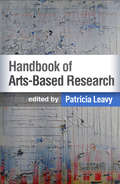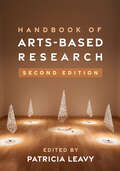- Table View
- List View
Handbook of Adolescent Transition Education for Youth with Disabilities
by Michael L. Wehmeyer Karrie A. ShogrenNow in a thoroughly revised and updated second edition, this handbook provides a comprehensive resource for those who facilitate the complex transitions to adulthood for adolescents with disabilities. Building on the previous edition, the text includes recent advances in the field of adolescent transition education, with a focus on innovation in assessment, intervention, and supports for the effective transition from school to adult life. The second edition reflects the changing nature of the demands of transition education and adopts a "life design" approach. This critical resource is appropriate for researchers and graduate-level instructors in special and vocational education, in-service administrators and policy makers, and transition service providers.
Handbook of Adolescent Transition Education for Youth with Disabilities
by Michael L. Wehmeyer Kristine W. WebbTransition from secondary education to adulthood represents a period during which adolescents with disabilities face multiple responsibilities and changing roles that include establishing independence, attending postsecondary education or training, developing social networks, choosing a career, participating in their communities, and managing healthcare and financial affairs. Sponsored by the Division of Career Development and Transition (DCDT) of the Council of Exceptional Children, this handbook provides a comprehensive resource to the communities of educators, related service and agency personnel, families, caretakers, counselors, and other stakeholders who facilitate these complex transitions to adulthood for adolescents with disabilities. Comprehensive – This comprehensive volume includes coverage of historical foundations, policy, transition programming and planning, development of student skills, and program structure. It also recommends transition supports for students with specific disabilities. Organizing Taxonomy – The book is organized around a well recognized taxonomy for adolescent transition used by many states to design and reform their transition services. Expertise – The volume editors are past-presidents of the Council for Exceptional Children’s Division on Career Development and are leaders in transition research and practice. Contributors are well-recognized for their expertise in transition. Chapter Structure – Each chapter includes a discussion of evidence-based research, recommended practices, suggestions for transition personnel and families, and additional resources. This book is appropriate for researchers and graduate-level instructors in special education and vocational education, inservice administrators and policy makers, and transition service providers.
Handbook of Adult Resilience
by John Reich Alex ZautraThe first book to move beyond childhood and adolescence to explore processes of resilience across the lifespan, this cutting-edge volume synthesizes the best current research in the field. Contributors offer a comprehensive examination of resilience at multiple levels of analysis, from genetic and physiological factors through individual, family, and community processes. Compelling topics include Whether resilience is best understood as a trait, a dynamic developmental process, an outcome, or all of the above. How resilience intersects with health and well-being across the adult life cycle. Cross-cultural issues in conceptualization and measurement. Ways to enhance adult resilience, including reviews of exemplary programs.
Handbook of Advanced Multilevel Analysis (European Association of Methodology Series)
by Joop J. HoxThis new handbook is the definitive resource on advanced topics related to multilevel analysis. The editors assembled the top minds in the field to address the latest applications of multilevel modeling as well as the specific difficulties and methodological problems that are becoming more common as more complicated models are developed. Each chapter features examples that use actual datasets. These datasets, as well as the code to run the models, are available on the book’s website http://www.hlm-online.com . Each chapter includes an introduction that sets the stage for the material to come and a conclusion. Divided into five sections, the first provides a broad introduction to the field that serves as a framework for understanding the latter chapters. Part 2 focuses on multilevel latent variable modeling including item response theory and mixture modeling. Section 3 addresses models used for longitudinal data including growth curve and structural equation modeling. Special estimation problems are examined in section 4 including the difficulties involved in estimating survival analysis, Bayesian estimation, bootstrapping, multiple imputation, and complicated models, including generalized linear models, optimal design in multilevel models, and more. The book’s concluding section focuses on statistical design issues encountered when doing multilevel modeling including nested designs, analyzing cross-classified models, and dyadic data analysis. Intended for methodologists, statisticians, and researchers in a variety of fields including psychology, education, and the social and health sciences, this handbook also serves as an excellent text for graduate and PhD level courses in multilevel modeling. A basic knowledge of multilevel modeling is assumed.
Handbook of Adverse Childhood Experiences: A Framework for Collaborative Health Promotion (Issues in Clinical Child Psychology)
by Michael C. Roberts Sharon G. Portwood Michael J. LawlerThis handbook explores ways to unify the study and application of adverse childhood experiences (ACEs) across multiple fields and disciplines, including clinical child and adolescent psychology, school psychology, pediatrics, social work, public health, education, and other health and human services. The book outlines a cohesive framework that organizes critical ACEs concepts throughout individual chapters, highlighting key issues and themes across settings and disciplines as well as gaps in current knowledge. Chapters examine interdisciplinary and collaborative approaches to ACEs and their impact on health and well-being within a specific topic area or setting. In addition, chapters review the foundations and development of the relevant science and provide examples of ACEs research and intervention applications as well as suggestions for continued advancement in this field. Key areas of coverage include: Definition and measurement of ACEs. Theory and models guiding ACEs research and practice. Applications of ACEs science across settings, including healthcare, mental and behavioral health, schools, justice system, and child welfare system. Applications of ACEs to public health and policy issues. Prevention strategies and policy approaches to ACEs. Handbook of Adverse Childhood Experiences is an essential resource for researchers, professors, and graduate students as well as clinicians and related mental health and medical therapists and professionals in developmental and clinical child and adolescent psychology, school psychology, child and adolescent psychiatry, social work, child and family studies, public health, pediatrics, and all interrelated disciplines.
Handbook of Affect and Social Cognition
by Joseph P. ForgasThis book offers a comprehensive review and integration of the most recent research and theories on the role of affect in social cognition and features original contributions from leading researchers in the field. The applications of this work to areas such as clinical, organizational, forensic, health, marketing, and advertising psychology receive special emphasis throughout. The book is suitable as a core text in advanced courses on the role of affect in social cognition and behavior or as a reference for those interested in the subject.
Handbook of African American Health
by Sandra Taylor Wornie Reed Anthony J. LemelleThe U.S. Census Bureau reports particular demographic, social, and health conditions for African Americans. Population-wide, the African American community has a higher mortality rate from cancer and diabetes than the rest of the population, a higher infant mortality rate, and a lower vaccination rate for influenza and pneumonia. The contributions to this comprehensive Handbook of African American Health uncover the specific demographic conditions of the African American population, and outline social interventions for both physical and mental health at the primary, secondary, and tertiary levels. The 26 contributions to this comprehensive volume cover interventions for a diverse range of health problems, including: -obesity and cardiovascular disease -diabetes -asthma and other respiratory diseases -smoking, alcohol, and recreational drug abuse -risky sexual behaviors -cancer screening, prevention, and survivorship -infant mortality -community and interpersonal violence -mental health From a healthcare standpoint, it also examines specific interventions for treatment compliance, health care access, and community collaborations. This volume will be an invaluable resource for researchers in medical sociology, mental health studies, public health, health behavior, and African American studies.
Handbook of African American Health
by Thomas Gullotta Robert HamptonWith a focus on how to improve the effectiveness and cultural competence of clinical services and research, this authoritative volume synthesizes current knowledge on both the physical and psychological health of African Americans today. In chapters that follow a consistent format for easy reference, leading scholars from a broad range of disciplines review risk and protective factors for specific health conditions and identify what works, what doesn't work, and what might work (i.e., practices requiring further research) in clinical practice with African Americans. Historical, sociocultural, and economic factors that affect the quality and utilization of health care services in African American communities are examined in depth. Evidence-based ways to draw on individual, family, and community strengths in prevention and treatment are highlighted throughout.
Handbook of Aging, Health and Public Policy: Perspectives from Asia
by S. Irudaya RajanThis handbook presents the latest information on all aspects of global aging, with a focus on Asia, including policies, age-associated diseases and conditions, health services, long-term care, living arrangements, income and social security, preventing abuse, and the impact of migration on the elderly. Furthermore, the book presents a synthesis of research on population aging, social protection policies, crimes against the elderly, new analyses of trends, and discussions of major social policy strategies. Written by academics, practitioners and policymakers in the field of gerontology, the book offers an informative resource for demographers, gerontologists, economists, anthropologists and other social scientists studying various facets of aging, as well as students in the social and health sciences.
Handbook of Alcoholism (Handbooks in Pharmacology and Toxicology)
by Gerald Zernig Alois Saria Martin Kurz Stephanie S. O’MalleyWhile the war on drugs continues to attract world attention, it is often overlooked that alcoholism remains a major worldwide health concern. No matter what your expertise, the CRC Handbook of Alcoholism can help you acquire the necessary skills to treat problem drinkers and alcohol-dependent patients.In three sections - Patient Care, Research,
Handbook of Alcoholism Treatment Approaches: Effective Alternatives, Third Edition
by William R. Miller Reid K. HesterThe Handbook of Alcoholism Treatment Approaches is a comprehensive, results-based guide to alcohol treatment methods. This handbook surveys the various models that have been used to define alcoholism, ending with a discussion of what the authors call "an informed eclecticism. " Using this approach, clinicians develop a spectrum of treatment approaches that have proved effective in practice, then match specific clients with the treatment methods that offer the greatest opportunities for success in these specific circumstances. This new edition of this handy reference provides both practitioners and researchers with a rich source of information on treatment interventions demonstrated to be the most successful. Clinical Psychologists and Alcohol Treatment Specialists.
Handbook of Anger Management and Domestic Violence Offender Treatment
by Ron Potter-EfronRonald T. Potter-Efron consciously connects anger management and domestic violence, two long separated fields, and addresses treatment options and intervention methods that meet the needs of individual clients, couples, families, and groups. Therapists, counselors, social workers, and other treatment specialists will find this book a useful overview and reference for anger and anger management techniques as well as domestic violence approaches. This new edition is split into four distinct sections:• A description of anger and domestic violence focused upon helping clients use the principles of neuroplasticity to dramatically alter their behavior• Assessment for anger problems and/or domestic violence• Group treatment for individuals with anger problems and/or domestic violence• Individual, couples, and family treatment of these concerns. Woven through this book is a fair and balanced treatment of gender issues, reflected in the diversity of case examples that address jealousy, chronic anger, behavioral problems, group and individual counseling, and more. Readers are also shown how anger develops and can lead to verbal and physical outbursts, the five types of rage reactions, and how to treat anger turned inward. Potter-Efron also details four different approaches to treating anger: behavioral, cognitive, affective, and existential/spiritual. Mental health professionals are provided numerous questionnaires and worksheets to utilize with their clients. Handbook of Anger Management and Domestic Violence Offender Treatment is an essential guidebook that illustrates effective theory and practice.
Handbook of Anger, Aggression, and Violence
by Victor R. Preedy Colin R. Martin Vinood B. PatelThis handbook provides a detailed overview of the emotional, physical, and social implications of anger, aggression, and violence. The book covers the recognition, diagnosis, and evaluation of these areas, aiming to understand the aetiology of these behavioral features to assist with prevention and cure. The book is divided into eight sections: Placing Aggression, Anger, Aggression and Violence In ContextCauses and Precipitation of Anger, Aggression and ViolenceFeatures of Anger, Aggression and ViolenceAnger, Aggression and Violence in Defined Disorders and ConditionsPhysical Measures of Pathology and Insights: GeneticsPhysical Measures of Pathology and Insights: Non-GeneticTreatments and TherapiesMethods and Techniques Handbook of Anger, Aggression, and Violence will be of use for behavioral scientists, psychologists, psychiatric nurses and doctors, neurologists, health scientists, general practitioners, research scientists and all those interested in altered behavior.
Handbook of Applied Behavior Analysis Interventions for Autism: Integrating Research into Practice (Autism and Child Psychopathology Series)
by Justin B. Leaf Mary Jane Weiss Joseph H. Cihon Julia L. FergusonThis handbook addresses evidence-based practices in Applied Behavior Analysis (ABA) for individuals diagnosed with autism spectrum disorder (ASD). It provides an overview of the history of evidence-based practices and their importance as applied to the law, school settings, and factors that influence the use for treatment of ASD. Additional areas of coverage include evidence-based and non-evidence-based ABA interventions for autism as well as decision-making ethics related to these treatments. In addition, the book addresses cultural considerations as they relate to these treatments and examines procedural aspects of ABA interventions for autism. Key ABA treatments addressed include: Discrete trial teaching. Pivotal response training. Video modeling. Parent-mediated intervention. Early Start Denver Model, PEAK, PECS, and AAC. Script fading/activity schedules and differential reinforcement/extinction. Response interruption and redirection. Self-management and self-monitoring. The Handbook of Applied Behavior Analysis Interventions for Autism is a must-have resource for researchers, professors, and graduate students as well as clinicians, therapists, and other professionals across such interrelated disciplines as clinical child, school, and developmental psychology, child and adolescent psychiatry, social work, rehabilitation medicine/therapy, pediatrics, and special education.
Handbook of Applied Behavior Analysis for Children with Autism: Clinical Guide to Assessment and Treatment (Autism and Child Psychopathology Series)
by Johnny L. MatsonThe handbook examines the latest advancements in applied behavior analysis (ABA) as the preferred method of treatment for children diagnosed with autism spectrum disorder (ASD). It synthesizes the most current research data and trends with best-practice interventions to form a comprehensive, state-of-the-art resource. The handbook reviews ABA research and practices in depth and identifies the interventions most relevant to children across the autism spectrum. Key areas of coverage include: Foundations of applied behavior analysis.ABA treatments for disorders comorbid with autism spectrum disorder.Functional assessment for children with autism.Operational definitions as well as observing and recording data for children with autism.The relationship of measures of psychopathology and applied behavior analysis.Transitioning across tasks for children with autism, including toe walking, feeding problems, and self-help issues.Anxiety, depression, and ADHD in children with autism. The Handbook of Applied Behavior Analysis for Children with Autism is an essential reference for researchers, clinicians and graduate students as well as clinicians, therapists, and other practitioners across such interrelated disciplines as clinical child, school, and developmental psychology, child and adolescent psychiatry, social work, rehabilitation medicine/therapy, pediatrics, and special education.
Handbook of Applied Behavior Analysis, Second Edition
by Wayne W. Fisher, Cathleen C. Piazza and Henry S. RoaneWidely regarded as the authoritative work on the principles and practice of applied behavior analysis (ABA), this indispensable volume is now in a revised and expanded second edition. Leading experts present evidence-based procedures for supporting positive behaviors and reducing problem behaviors with children and adults in diverse contexts. Chapters delve into applications in education, autism treatment, addictions, behavioral pediatrics, and other areas. Covering everything from behavioral assessment and measurement to the design and implementation of individualized interventions, the Handbook is a complete reference and training tool for ABA practitioners and students. New to This Edition *Incorporates key advances in research, theory, and clinical practice. *Chapters on additional applications: school consultation, pediatric feeding disorders, and telehealth services. *Chapters on quantitative analysis of behavior (matching and behavioral momentum theory) and behavioral economics. *Updated discussions of professional issues, ABA certification, and technology tools.
Handbook of Applied Behavior Analysis: Integrating Research into Practice (Autism and Child Psychopathology Series)
by Johnny L. MatsonThis book provides comprehensive coverage of applied behavioral analysis (ABA). It examines the history and training methods of ABA as well as related ethical and legal issues. The book discusses various aspects of reinforcement, including social reinforcers, tangible reinforcers, automatic reinforcement, thinning reinforcers, and behavioral momentum. It addresses basic training strategies, such as prompts and fadings, stimulus fading, and stimulus pairing and provides insights into auditory/visual discrimination, instructional feedback, generalization, error correction procedures, and response interruption. In addition, the book addresses the use of ABA in education and explores compliance training, on-task behavior, teaching play and social skills, listening and academic skills, technology, remembering and cognitions, picture-based instruction, foreign language instruction, teaching verbal behavior, public speaking, and vocational skills. In addition, the book covers treatments for tics, trichotillomania, stereotypies, self-injurious behavior, aggression, and toe walking. It also addresses ABA for special populations, including individuals with autism, ADHD, substance abuse, and intellectual disabilities.Featured areas of coverage include:Basic assessment methods, such as observing behavior, treatment integrity, social validation, evaluating physical activity, measuring sleep disturbances, preference assessment, and establishing criteria for skill mastery.Functional assessment, including how to quantify outcomes and evaluate results, behaviors that precede and are linked to target behaviors, and treatments.Treatment methods, such as token economies, discrete trial instruction, protective equipment, group-based and parent training as well as staff training and self-control procedures.Health issues, including dental and self-care, life skills, mealtime and feeding, telehealth, smoking reduction and cessation, and safety training.Leisure and social skills, such as cellphone use, gambling, teaching music, sports and physical fitness.The Handbook of Applied Behavior Analysis is a must-have reference for researchers, professors, and graduate students as well as clinicians, therapists, and other professionals in clinical child and school psychology, child and adolescent psychiatry, social work, behavioral therapy and rehabilitation, special education, developmental psychology, pediatrics, nursing, and all interrelated disciplines.
Handbook of Applied Developmental Science in Sub-Saharan Africa
by Amina Abubakar Fons J.R. van de VijverThis handbook collates research evidence and presents the most up-to-date findings on child development in Sub-Saharan Africa. It discusses complex risk factors and medical conditions affecting childhood outcomes, and spotlights emerging programs for enhancing literacy and cognitive development. The panel of expert contributors offer needed context and knowledge to the discussion of previously understudied topics. Chapters present proven intervention strategies currently in use across the diverse region. In addition, this handbook provides guidelines for culturally sensitive and ethical research that will inform practice and help shape policy goals and initiatives. Topics featured in the Handbook include: #65533; Fatherhood in the African context. #65533; Sibling care-giving and its implications in Sub-Saharan Africa. #65533; Nutritional status, infections, and child development #65533; Diabetes in Sub-Saharan African children. #65533; How to adapt tests for Sub-Saharan Africa. #65533; Interventions aimed at children and caregivers. #65533; A culturally sensitive approach to conducting research and promoting initial literacy development in Africa The Handbook of Applied Developmental Science in Sub-Saharan Africa is a must-have resource for researchers, professionals/scientist-practitioners, and graduate students in child, school, and developmental psychology, as well as pediatrics, social work, public health, and education.
Handbook of Applied Psycholinguistics: Major Thrusts of Research and Theory
by Sheldon RosenbergFirst published in 1982. The chapters of this handbook contain critical integrative reviews of research and theory in the major areas of the field of applied psycholinguistics, the field in which applied problems of language and communicative functioning and development are approached from the standpoint of basic research and theory in psycholinguistics and related areas of cognitive psychology. The book was designed to meet the needs of researchers, practitioners and graduate students from such disciplines as education (including special education), language learning, linguistics, neurology, psychiatry, psychology, and speech and hearing for such reviews, although the state of research in an area and a desire to stress research and theory in substantive areas resulted in a decision not to include chapters on the measurement of linguistic maturity, language intervention, the language of the learning disabled child, language and environmental deprivation, language and mania, language and senile dementia, and the design of written and oral information and computer command language.
Handbook of Approach and Avoidance Motivation
by Andrew J. ElliotOf the many conceptual distinctions present in psychology today, the approach-avoidance distinction stands out as one of, if not the, most fundamental and basic. The distinction between approach and avoidance motivation has a venerable history, not only within but beyond scientific psychology, and the deep utility of this distinction is clearly evident across theoretical traditions, disciplines, and content areas. This volume is designed to illustrate and highlight the central importance of this distinction, to serve as a one-stop resource for scholars working in this area, and to facilitate integration among researchers and theorists with an explicit or implicit interest in approach and avoidance motivation. The main body of this volume is organized according to seven broad sections that represent core areas of interest in the study of approach and avoidance motivation, including neurophysiology and neurobiology, and evaluative processes. Each section contains a minimum of four chapters that cover a specific aspect of approach and avoidance motivation. The broad applicability of the approach-avoidance distinction makes this Handbook an essential resource for researchers, theorists, and students of social psychology and related disciplines.
Handbook of Arab American Psychology
by Germine H. Awad Mona M. AmerThe Handbook of Arab American Psychology is the first major publication to comprehensively discuss the Arab American ethnic group from a lens that is primarily psychological. This edited book contains a comprehensive review of the cutting-edge research related to Arab Americans and offers a critical analysis regarding the methodologies and applications of the scholarly literature. It is a landmark text for both multicultural psychology as well as for Arab American scholarship. Considering the post 9/11 socio-political context in which Arab Americans are under ongoing scrutiny and attention, as well as numerous misunderstandings and biases against this group, this text is timely and essential. Chapters in the Handbook of Arab American Psychology highlight the most substantial areas of psychological research with this population, relevant to diverse sub-disciplines including cultural, social, developmental, counseling/clinical, health, and community psychologies. Chapters also include content that intersect with related fields such as sociology, American studies, cultural/ethnic studies, social work, and public health. The chapters are written by distinguished scholars who merge their expertise with a review of the empirical data in order to provide the most updated presentation of scholarship about this population. The Handbook of Arab American Psychology offers a noteworthy contribution to the field of multicultural psychology and joins references on other racial/ethnic minority groups, including Handbook of African American Psychology, Handbook of Asian American Psychology, Handbook of U.S. Latino Psychology, and The Handbook of Chicana/o Psychology and Mental Health.
Handbook of Art Therapy, Second Edition
by Cathy A. MalchiodiWidely regarded as the standard reference in the field, this handbook provides a complete overview of art therapy, from theory and research to practical applications. Leading practitioners demonstrate the nuts and bolts of arts-based intervention with children, adults, families, couples, and groups dealing with a wide range of clinical issues. Rich with illustrative case material, the volume features 110 sample drawings and other artwork. The inclusion of diverse theoretical approaches and practice settings makes the Handbook eminently useful for all mental health professionals interested in using art in evaluation and treatment. New to This Edition Incorporates the latest clinical applications, methods, and research. Chapter on art materials and media (including uses of new technologies). Chapters on intervening with domestic violence survivors, bereaved children, and military personnel. Expanded coverage of neuroscience, cultural diversity, and ethics.
Handbook of Arts-Based Research
by Patricia LeavyBringing together interdisciplinary leaders in methodology and arts-based research (ABR), this comprehensive handbook explores the synergies between artistic and research practices and addresses issues in designing, implementing, evaluating, and publishing ABR studies. Coverage includes the full range of ABR genres, including those based in literature (such as narrative and poetic inquiry); performance (music, dance, playbuilding); visual arts (drawing and painting, collage, installation art, comics); and audiovisual and multimethod approaches. Each genre is described in detail and brought to life with robust research examples. Team approaches, ethics, and public scholarship are discussed, as are innovative ways that ABR is used within creative arts therapies, psychology, education, sociology, health sciences, business, and other disciplines. The companion website includes selected figures from the book in full color, additional online-only figures, and links to online videos of performance pieces. See also Dr. Leavy's authored book, Method Meets Art, Second Edition, an ideal course text that provides an accessible introduction to ABR.
Handbook of Arts-Based Research
by Patricia LeavyThe first methods handbook devoted solely to arts-based research (ABR) is now in a thoroughly updated second edition, featuring a new section on global perspectives plus new chapters on critical approaches and documentary film. The volume explores the synergies between contemporary artistic and research practices and addresses issues in designing, implementing, evaluating, and publishing ABR studies. Chapters are written by leading practitioners of each ABR genre, including those based in literature (such as narrative inquiry, fiction, and poetry); performance (music, dance, ethnodrama); visual arts (drawing, painting, collage, installation art, comics); and audiovisual and multimethod approaches. Team approaches, ethics, social justice concerns, and public scholarship are discussed, as are innovative ways that ABR is used within creative arts therapies, psychology, education, sociology, health sciences, and other disciplines. The companion website includes selected figures from the book in full color, additional online-only figures, and links to online videos of performance pieces. New to This Edition Updated throughout with current research, theory, and ABR examples. Chapters on critical approaches to ABR and on documentary film. Chapters on ABR projects in Taiwan, Japan, and the United Kingdom.
Handbook of Asian Aging
by Jon Hendricks Hyunsook YoonIn western countries, the rising tide of population aging took 100 years to alter the face of societies, but Asia is experiencing comparable changes in not much more than a quarter of a century. Contributors to "The Handbook of Aging" describe the magnitude of these changes and their effects on the aged and on societies attempting to adapt to the dramatic improvements in life expectancy brought on by rapid economic and social transformations. Asia encompasses a vast reach from Pakistan and India to Japan, the Philippines, and Indonesia, and in this book including Australia. "The Handbook of Aging" provides a framework for making sense of the meeting between reverential views of the elderly and contemporary priorities as Asia arrives at the crossroads. The need for innovative approaches to social policy and personal practices is nowhere more evident than in Asian countries, where modern marketing economies have forced hard political choices. The economic tigers of the Asian-Pacific region experienced the aging of their populations ahead of other Asian countries, but solutions reached during times of financial boom are being re-examined as economies come back to earth, with soft or hard landings. "The Handbook of Asian Aging" provides an atlas of the far-reaching changes that are afoot and that will become even more pronounced in the near future.
